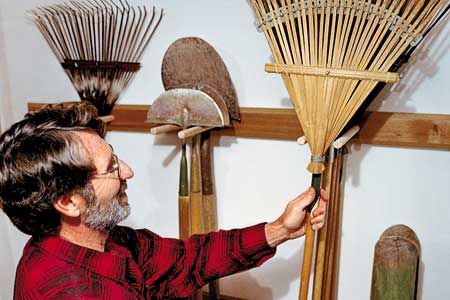Neat and Tidy
Rather than leave my rakes and other long-handled tools in a jumble in the garage, I made these simple racks out of redwood 2x4s and pairs of 1-inch dowels. I just drilled 1-inch holes into the wood at a slight angle, glued in the dowels, then screwed the lumber to the studs so that the dowels angled upward. As you can see, the dowel pairs on the top rack are offset relative to those on the bottom rack. That way, the handles on top won’t interfere with the tools below. Leaf rakes have wide heads, so I always put them on the top rack.
Working the Angles
I hold a garden rake in two basic positions, depending on what I’m trying to do. The lower the handle is to the ground, the more stuff you’ll grab. The higher the handle, the more delicately you can move things around. Remember to take short strokes. It’s less tiring and easier on your back than reaching long.
Norm’s Tip
When pouring slabs and footings, an iron garden rake—held tines down—is just the tool to move the concrete around. With tines up, it also levels nicely, if you don’t mind it leaving a rough surface. Just don’t forget to hose off the rake before the concrete on it sets.

